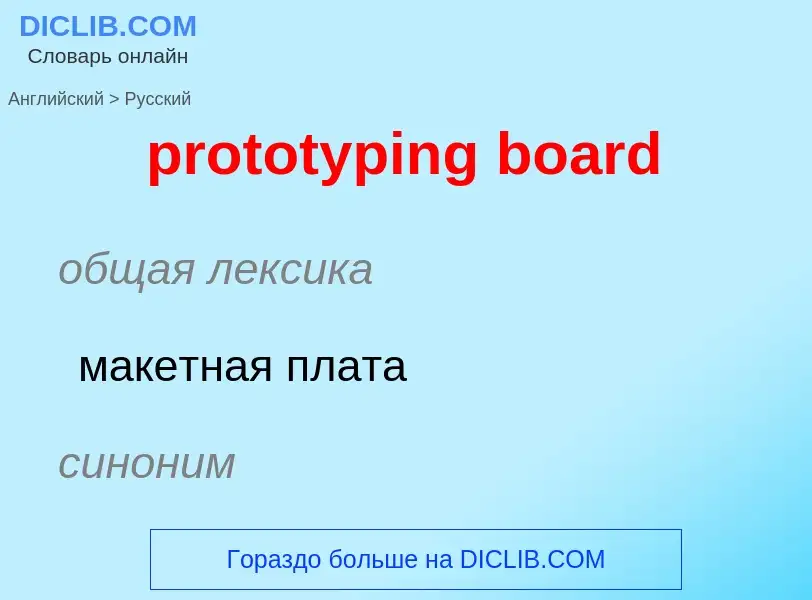Перевод и анализ слов искусственным интеллектом ChatGPT
На этой странице Вы можете получить подробный анализ слова или словосочетания, произведенный с помощью лучшей на сегодняшний день технологии искусственного интеллекта:
- как употребляется слово
- частота употребления
- используется оно чаще в устной или письменной речи
- варианты перевода слова
- примеры употребления (несколько фраз с переводом)
- этимология
prototyping board - перевод на Английский
общая лексика
быстрое макетирование, быстрое создание опытных образцов
создание работающей модели приложения или системы для демонстрации заказчику для обеспечения ранней обратной связи или проверки возможности реализации. Прототип позже уточняется для получения конечного продукта
общая лексика
передаточный коммутатор
[ful'bɔ:d]
общая лексика
полный пансион
существительное
общая лексика
полный пансион
[hɑ:f'bɔ:d]
общая лексика
полупансион
половинный пансион (завтрак и ужин)
существительное
общая лексика
полупансион
['bɔ:dgeim]
общая лексика
настольная игра (шахматы и т. п.)
нефтегазовая промышленность
брус-подкладка под домкрат
опора для труб (при сборке трубопровода)
Определение
Википедия
Printed circuit board milling (also: isolation milling) is the process of removing areas of copper from a sheet of printed circuit board material to recreate the pads, signal traces and structures according to patterns from a digital circuit board plan known as a layout file. Similar to the more common and well known chemical PCB etch process, the PCB milling process is subtractive: material is removed to create the electrical isolation and ground planes required. However, unlike the chemical etch process, PCB milling is typically a non-chemical process and as such it can be completed in a typical office or lab environment without exposure to hazardous chemicals. High quality circuit boards can be produced using either process. In the case of PCB milling, the quality of a circuit board is chiefly determined by the system's true, or weighted, milling accuracy and control as well as the condition (sharpness, temper) of the milling bits and their respective feed/rotational speeds. By contrast, in the chemical etch process, the quality of a circuit board depends on the accuracy and/or quality of the mask used to protect the copper from the chemicals and the state of the etching chemicals.

![A rapid prototyping machine using [[selective laser sintering]] (SLS) A rapid prototyping machine using [[selective laser sintering]] (SLS)](https://commons.wikimedia.org/wiki/Special:FilePath/3dprinter.jpg?width=200)




![damah]]'' damah]]''](https://commons.wikimedia.org/wiki/Special:FilePath/Board game damah at Souq Waqif.jpg?width=200)
![District Messenger Boy]]'' (1886) District Messenger Boy]]'' (1886)](https://commons.wikimedia.org/wiki/Special:FilePath/District Messenger Boy Box Cover 1886.jpg?width=200)

![The modern German board game ''[[Catan]]'' is printed in 30 languages and sold 15 million by 2009. The modern German board game ''[[Catan]]'' is printed in 30 languages and sold 15 million by 2009.](https://commons.wikimedia.org/wiki/Special:FilePath/Nepomuk 280 - Osadníci z Katanu.jpg?width=200)
![Young girls playing a board game in the [[Iisalmi]], Finland, library in 2016 Young girls playing a board game in the [[Iisalmi]], Finland, library in 2016](https://commons.wikimedia.org/wiki/Special:FilePath/Pelipäivä Iisalmen kaupunginkirjastossa.jpg?width=200)
![[[Senet]], one of the oldest known board games [[Senet]], one of the oldest known board games](https://commons.wikimedia.org/wiki/Special:FilePath/Maler der Grabkammer der Nefertari 003.jpg?width=200)
![Egypt, 13th Dynasty]]) Egypt, 13th Dynasty]])](https://commons.wikimedia.org/wiki/Special:FilePath/Game of Hounds and Jackals MET DP264105.jpg?width=200)

![Royal game of Ur]], southern Iraq, about 2600–2400 BCE Royal game of Ur]], southern Iraq, about 2600–2400 BCE](https://commons.wikimedia.org/wiki/Special:FilePath/British Museum Royal Game of Ur.jpg?width=200)
![Macuilxochitl]] as depicted on page 048 of the [[Codex Magliabechiano]] Macuilxochitl]] as depicted on page 048 of the [[Codex Magliabechiano]]](https://commons.wikimedia.org/wiki/Special:FilePath/Macuilxochitl Patolli.png?width=200)


![An early [[games table desk]] (Germany, 1735) featuring [[chess]]/[[draughts]] (left) and [[nine men's morris]] (right) An early [[games table desk]] (Germany, 1735) featuring [[chess]]/[[draughts]] (left) and [[nine men's morris]] (right)](https://commons.wikimedia.org/wiki/Special:FilePath/Gaming table with chessboard.jpg?width=200)

